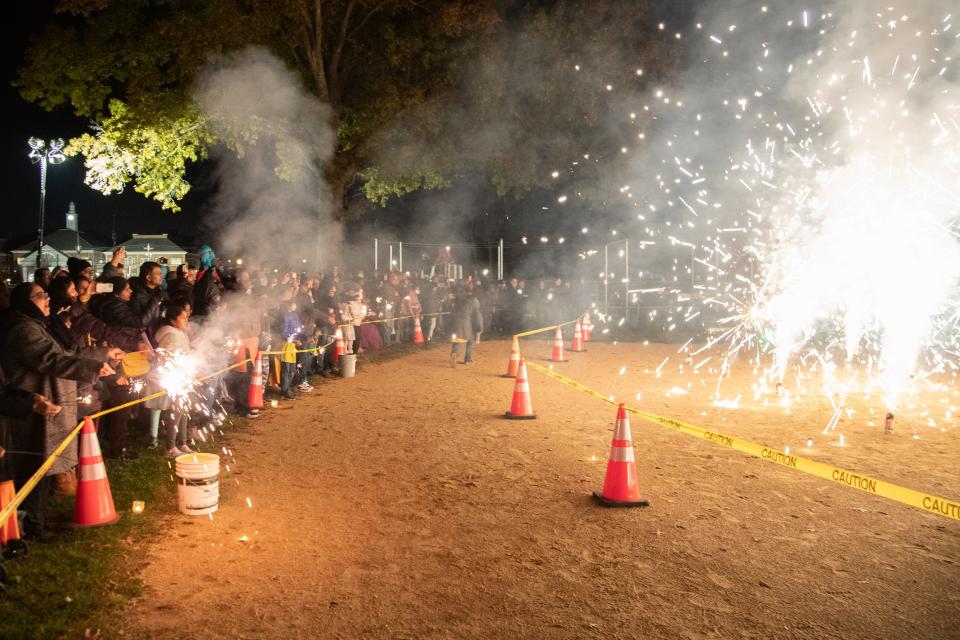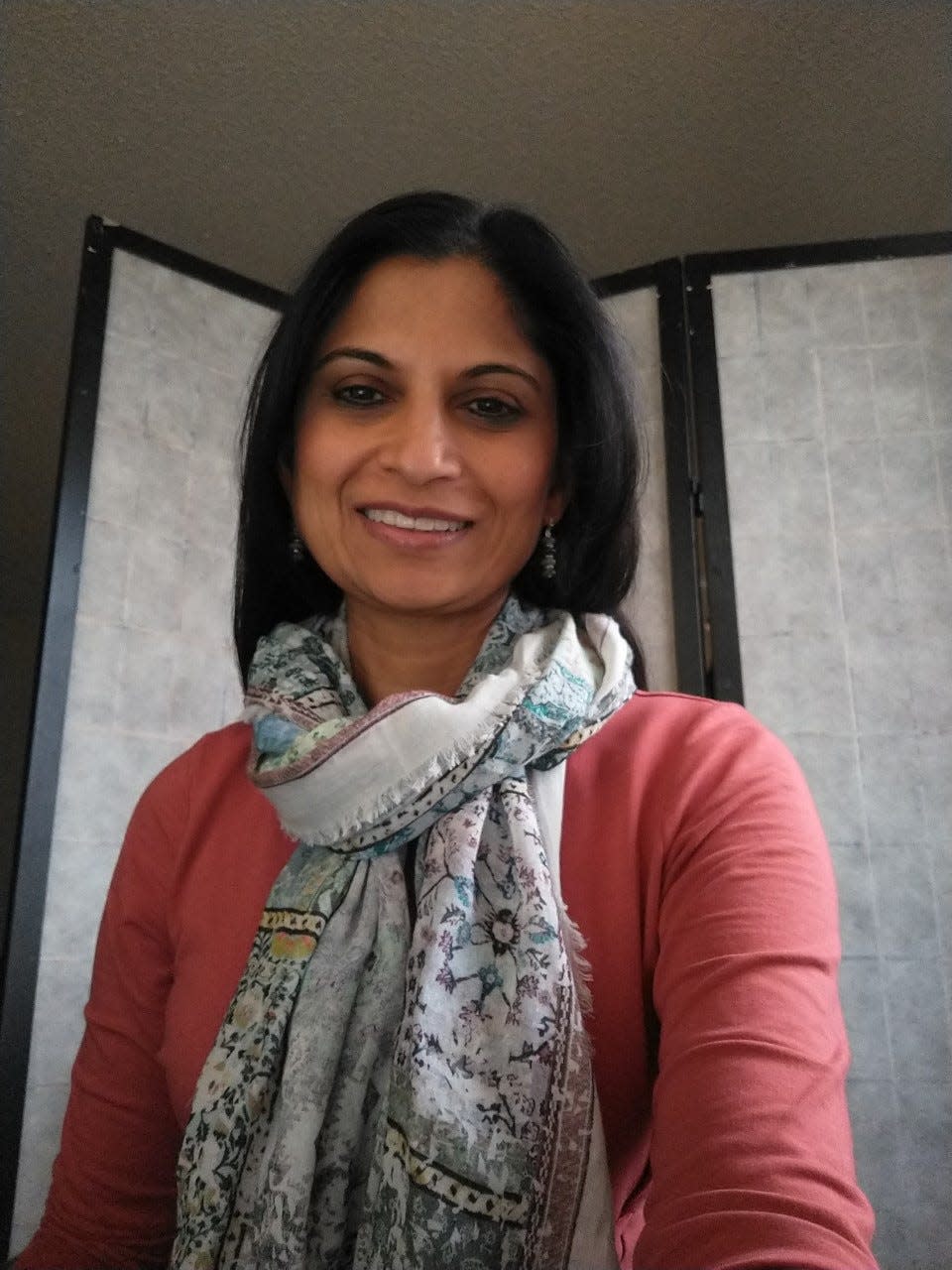Diwali: Why I celebrate the triumph of good over evil in diverse New Jersey | Opinion
Diwali — or Deepavali, as it's called by my South Indian friends — celebrates the triumph of good over evil. Before I tell you the story of Rama, which is one of the main stories at the center of the celebration of Diwali/Deepavali for many of the Indian diaspora, though maybe not your immediate South Asian neighbor, I must make a confession. When I moved to New Jersey, I didn’t at first understand why in October homes were decorated with lights, which you’re seeing right now across the Garden State.
I grew up in the midwest in the 70s and 80s, a time when assimilation was the blueprint to becoming American. As my parents have told me, walking through America’s golden door meant the opportunity to free themselves from the Indian caste system that hindered their full flourishing. Becoming American also meant that my parents listened to teachers when they said that at home, my parents shouldn’t speak to my older brother and me in their mother tongue because it would confuse us and hinder our mastery of English. Becoming American also meant that we didn’t celebrate Hindu holidays — we celebrated, with so much immigrant enthusiasm, Thanksgiving, Christmas, Valentine’s Day, St. Patrick’s Day and Easter. Speaking recently with my 74-year-old father about those growing-up years, he pulled out one of his favorite idioms, “When in Rome, do as the Romans do.”
My son’s growing up was so different from my own because he grew up here in the Garden State, which has an Asian population of 10.4 %. He also attended school in a district that has a majority of students of Asian heritage. During his years in high school, Diwali was a day off. Raising a child in New Jersey opened up opportunities to celebrate, openly, my heritage.
Like other members of the South Asian community in our state, we decorate the outside of our house with lights in mid-October.
Indian holidays are always associated with sweets — mithai. In our early years in the state, I used to drive to Edison to buy mithai from the Bengali Sweet Shop or my local Indian grocery store. Nowadays, I make a quick stop to Sukhadia’s Indian Grill in Parsippany. If I have more time, I drive to my new favorite place for mithai, the Sri Swaminarayan temple in Robbinsville, which has the most remarkably crafted Indian sweets you will ever taste.

As night falls on Diwali/Deepavali, my family lights clay diyas in the traditional way. This is my husband’s job. He fills each diya with a spoon of melted ghee. He then pulls a bit of cotton from a cotton ball, which I buy at the Indian grocery store. He twists the bit of cotton between his fingers to fashion a wick and immerses the bottom of the wick in the melted ghee. When I do this, the wick doesn’t always light, so I reach for a tea candle, instead, and place it inside the diya. My son turns off all the lights in the house. He and his father place diyas in the doorway of each room and diyas outside the house in each of the cardinal directions. Inside the kitchen, which is lit with diyas, I wait for their return.
The tale of Rama and the Demon King
When my son was in elementary school, I used to read him a picture book called "Rama and the Demon King: An Ancient Tale from India" by Jessica Souhami. Here is a shortened version of that story.
In the kingdom of Ayodhya, lives a prince named Rama, an incomparable archer and warrior. He is kind and compassionate to the people, who adore him. He is the favorite of the king, his father, but not his stepmother. She hates him and, through wily ways, convinces the king to exile Rama. He leaves the kingdom accompanied by his beautiful wife Sita and his younger brother Lakshman.
They journey into the woods and are attacked by demons. Both brothers are skilled archers and they kill the demons except one, who escapes. Rama, Lakshman, and Sita build a hut in the forest and resign to living in exile.
Meanwhile, the demon that escaped travels to Lanka, the home of the Demon King Ravana. Ravana learns what happened in the forest, and he has only one thought: revenge.
Ravana flies his chariot above the forests and easily finds them. He sees the two brothers talking outside their hut. He sizes them up and is confident he can defeat them in one fell swoop. hut, When Sita comes out of the hut, he is enamored and wants only to make her his, and now. And now. He conjures up an enchanting golden deer, which prances out of the dark forest and stops in front of Sita. Sita can’t resist wanting to pet the unusual creature, but before she does, it darts away into the dark forest. Rama says he’ll catch the deer and bring it back for her. Before Rama leaves, he tells Lakshman to stay and protect Sita.
From behind the trees, Ravana changes his voice to sound like Rama’s, “Help me!" Lakshman wants to run to his brother but he doesn’t want to break his promise to keep Sita safe. Sita says to Lakshman he must go help Rama.
After Lakshman disappears into the forest, Ravana swoops down and kidnaps Sita. He flies back to his kingdom in Lanka.
The two brothers quickly realize they’ve been duped. They rush back to their hut and find Sita gone. They search everywhere for her in the forest. Walking southward, they find her dupatta — a scarf — and, further south, an earring. They continue traveling southward, but they can’t find her. When they reach the kingdom of monkeys, they tell the Monkey King, Hanuman, their troubles. Hanuman says that he will help them search for Sita. Hanuman, having the power of flight, flies over the entire land and finally finds Sita in Lanka.
Rama, Lakshman, Hanuman, and the monkey army prepare for battle. To reach Lanka they have to cross an ocean. They create a bridge made of stones. When they arrive in the kingdom, a mighty battle ensues. Ravana conjures up all his evil powers, but Rama vanquishes him. Dussehra is the celebration of Rama’s defeat of the Demon King Ravana.
Twenty days later, on Diwali/Deepavali, Hindus light diya lamps to symbolically guide Rama, Sita, and Lakshman’s journey back home to the kingdom of Ayodhya. When they arrive, Rama learns his father has died of heartache. Rama is crowned king and rules with compassion and bravery.
On Diwali/Deepavali night, my home is lit from the outside with white lights, diyas burn in the four cardinal directions, and inside diyas are aglow. My son, my husband and I are seated around the kitchen table eating one sweet after another. Some years, we fill up on so many sweets, we skip dinner entirely.
I began with a confession and I’ll end with one, too. I leave my outside lights decorating my home lit at night from October through through Hanukkah, Kwanzaa and Christmas. This is what it means to be an American, and very proudly, a New Jerseyan.
Sima Kumar is a New Jersey educator and member of Make Us Visible-New Jersey, a grassroots coalition that successfully helped pass the AAPI curriculum bills that Gov. Phil Murphy signed into law in January 2022.

This article originally appeared on NorthJersey.com: Diwal in NJ Why I celebrate the triumph of good over evil

